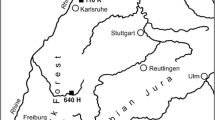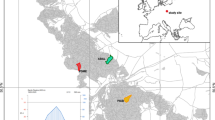Abstract
Climate warming is predicted to extend the duration and enhance the severity of summer droughts in Central Europe, which may pose a serious risk to forest productivity and forest health. Fagus sylvatica (European beech), the most abundant tree species of Central Europe’s natural forest vegetation and one of the key species in forestry, is thought to be particularly vulnerable to drought. Here, we present a dendrochronological analysis in three mixed temperate broad-leaved forests along a precipitation gradient with the aim of comparing the climatic response of radial growth of F. sylvatica with the performance of four co-existing species (Acer pseudoplatanus, A. platanoides, Quercus petraea, Fraxinus excelsior). We hypothesized that Fagus is the most drought sensitive of the five species, which implies that it could lose its competitive advantage at drier sites in the course of climate warming. In support of this hypothesis, we found that F. sylvatica in all stands exhibited an increase in the number of negative pointer years and a decrease in radial increment in the driest stand since about 1980, in parallel to increasing summer temperatures and drought intensity. Such a response was missing in the other four species and may point to shifts in the competitive hierarchy in these mixed forests under a future warmer climate. We conclude that Central Europe’s forestry sector should consider carefully the risk of failure of beech in regions with relatively low and decreasing summer precipitation.








Similar content being viewed by others
References
Allen CD, Macalady AK, Chenchouni H, Bachelet D, McDowell N, Vennetier M, Kitzberger T, Rigling A, Breshears DD, Hogg EH, Gonzalez P, Fensham R, Zhang Z, Castro J, Demidova N, Lim JH, Allard G, Running SW, Semerci A, Cobb N. 2010. A global overview of drought and heat-induced tree mortality reveals emerging climate change risks for forests. For Ecol Manage 259:660–84.
Backes K, Leuschner C. 2000. Leaf water relations of competitive Fagus sylvatica and Quercus petraea trees during 4 years differing in soil drought. Can J For Res 30:335–46.
Baillie MG, Pilcher JR. 1973. A simple cross-dating program for tree-ring research. Tree-Ring Bull 33:7–14.
Barbeta A, Ogaya R, Penuelas J. 2013. Dampening effects of long-term experimental drought on growth and mortality rates of a Holm oak forest. Glob Change Biol 19:3133–44.
Bonn S. 1998. Dendroökologische Untersuchung der Konkurrenzdynamik in Buchen/Eichen-Mischbeständen und zu erwartende Modifikationen durch Klimaänderungen. Forstwiss Beitr Tharandt/Contr For Sc 3:1–226.
Bräuning A. 1999. Zur Dendroklimatologie Hochtibets während des letzten Jahrtausends. Diss Bot 312:1–164.
Bréda N, Huc R, Granier A, Dreyer E. 2006. Temperate forest trees and stands under severe drought: a review of ecophysiological responses, adaptation processes and long-term consequences. Ann For Sci 63:625–44.
Bunn AG. 2008. A dendrochronology program library in R (dplR). Dendrochronologia 26:115–24.
Cavin L, Mountford PE, Peterken GF, Jump AS. 2013. Extreme drought alters competitive dominance within and between tree species in a mixed forest stand. Funct Ecol 27:1424–35.
Dixon PM. 2001. Bootstrap resampling. In: El-Shaarawi AH, Piegorsch WW, Ed. The Encyclopedia of Environmetrics. New York: Wiley. p. 212–220.
Drobyshev I, Övergaard R, Saygin I, Niklasson M, Hickler T, Karlsson M, Sykes MT. 2010. Masting behaviour and dendrochronology of European beech (Fagus sylvatica L.) in southern Sweden. For Ecol Manage 259:2160–71.
Eckstein D, Bauch J. 1969. Beitrag zur Rationalisierung eines dendrochronologischen Verfahrens und zur Analyse seiner Aussagesicherheit. Forstwissenschaftlisches Centralblatt 88:230–50.
Ellenberg H, Leuschner C. 2010. Vegetation Mitteleuropas mit den Alpen in ökologischer, dynamischer und historischer Sicht. 6th edn. Stuttgart: Ulmer.
Filewod B. 2011. Effects of an early season heat wave on ecophysiological parameters related to productivity in Sugar maple (Acer saccharum Marsh.). MSc Thesis, Faculty of Forestry, University of Toronto, Canada.
Fonti P, García-González I. 2008. Earlywood vessel size of oak as a potential proxy for spring precipitation in mesic sites. J Biogeogr 35:2249–57.
Fritts HC. 2001. Tree rings and climate. Caldwell: Blackburn Press.
Genet H, Breda N, Dufrene E. 2010. Age-related variation in carbon allocation at tree and stand scales in beech (Fagus sylvatica L.) and sessile oak (Quercus petraea (Matt.) Liebl.) using a chronosequence approach. Tree Physiol 30:177–92.
Guiot J. 1991. The bootstrapped response function. Tree-Ring Bull 51:39–41.
Härdtle W, Niemeyer T, Assmann T, Aulinger A, Fichtner A, Lang A, Leuschner C, Neuwirth B, Pfister L, Quante M, Ries C, Schuldt A, von Oheimb G. 2013. Climatic responses of tree-ring width and δ13C signatures of sessile oak (Quercus petraea Liebl.) on soils with contrasting water supply. Plant Ecol 214:1147–56.
Hertel D, Strecker T, Müller-Haubold H, Leuschner C. 2013. Fine root biomass and dynamics in beech forests across a precipitation gradient—is optimal resource partitioning theory applicable to water-limited mature trees? J Ecol 101:1183–200.
Hilton GM, Packham JR. 2003. Variation in the masting of common beech (Fagus sylvatica L.) in northern Europe over two centuries (1800-2001). Forestry 76:319–28.
IPCC. 2013. Summary for policymakers. In: Stocker TF, Qin D, Plattner GK, Tignor M, Allen SK, Boschung J, Nauels A, **a Y, Bex V, Midgley PM, Eds. Climate Change 2013: The Physical Science Basis. Contribution of Working Group I to the Fifth Assessment Report of the Intergovernmental Panel on Climate Change. Cambridge: Cambridge University Press.
Jacob D. 2009. Regionalisierte Szenarien des Klimawandels. Raumforschung und Raumordnung 67:89–96.
Jump AS, Hunt JM, Penuelas J. 2006. Rapid climate change-related growth decline at the southern range edge of Fagus sylvatica. Glob Change Biol 12:2163–74.
Köcher P, Gebauer T, Horna V, Leuschner C. 2009. Leaf water status and stem xylem flux in relation to soil drought in five temperate broad-leaved tree species with contrasting water use strategies. Ann For Sci 66:101.
Köcher P, Horna V, Leuschner C. 2012. Environmental control of daily stem growth patterns in five temperate broad-leaved tree species. Tree Physiol 32:1021–32.
Leuschner C. 2009. Die Trockenheitsempfindlichkeit der Rotbuche vor dem Hintergrund des prognostizierten Klimawandels. Jahrbuch der Akademie der Wissenschaften zu Göttingen. Berlin: Walter de Gruyter. p 281–96.
Leuschner C, Backes K, Hertel D, Schipka F, Schmitt U, Terborg O, Runge M. 2001. Drought responses at leaf, stem and fine root levels of competitive Fagus sylvatica L. and Quercus petraea (Matt.) Liebl. trees in dry and wet years. For Ecol Manage 149:33–46.
Mainiero R, Kazda M. 2006. Depth-related fine root dynamics of Fagus sylvatica during exceptional drought. For Ecol Manage 237:135–42.
Meier IC, Leuschner C. 2008. Leaf size and leaf area index in Fagus sylvatica forests: competing effects of precipitation, temperature, and nitrogen availability. Ecosystems 11:655–69.
Mette T, Dolos K, Meinardus C, Bräuning A, Reineking B, Blaschke M, Pretzsch H, Beierkuhnlein C, Gohlke A, Wellstein C. 2013. Climate turning point for beech and oak under climate change in Central Europe. Ecosphere 4:1–19.
Müller-Haubold H, Hertel D, Seidel D, Knutzen F, Leuschner C. 2013. Climate responses of aboveground productivity and allocation in Fagus sylvatica: a transect study in mature forests. Ecosystems 16:1498–516.
Övergaard R, Gemmel P, Karlsson M. 2007. Effects of weather conditions on mast year frequency in beech (Fagus sylvatica L.) in Sweden. Forestry 80:555–65.
Piovesan G, Adams JM. 2001. Masting behaviour in beech: linking reproduction and climatic variation. Can J Bot 79:1039–47.
Piovesan G, Biondi F, Di Fillipo A, Maugeri M. 2008. Drought-driven growth reduction in old beech (Fagus sylvatica L.) forests of the central Apennines, Italy. Glob Change Biol 14:1265–81.
R Development Core Team. 2008. R: A language and environment for statistical computing. R Foundation for Statistical Computing, Vienna, Austria. ISBN 3-900051-07-0, URL http://www.R-project.org.
Rennenberg H, Seiler W, Matyssek R, Gessler A, Kreuzwieser J. 2004. European beech (Fagus sylvatica L.)—a forest tree without future in the south of Central Europe? Allgemeine Forst- und Jagdzeitung 175:210–24.
Schär C, Vidale PL, Lüthi D, Frei C, Häberli C, Liniger MA, Appenzeller C. 2004. The role of increasing temperature variability in European summer heatwaves. Nature 427:332–6.
Scharnweber T, Manthey M, Criegee C, Bauwe A, Schröder A, Wilmking M. 2011. Drought matters—declining precipitation influences growth of Fagus sylvatica L. and Quercus robur L. in north-eastern Germany. For Ecol Manage 262:947–61.
Scherrer D, Bader KFB, Körner C. 2011. Drought-sensitivity ranking of deciduous tree species based on thermal imaging of forest canopies. Agric For Meteorol 151:1632–40.
Schmidt W. 2006. Temporal variation in beech masting (Fagus sylvatica L.) in a limestone beech forest (1981–2004). Allgemeine Forst- und Jagdzeitung 177:9–19.
Schönwiese CD, Janoschitz R. 2008. Klima-Trendatlas Deutschland 1901–2000. Germany: Berichte des Instituts für Atmosphäre und Umwelt der Universität Frankfurt/Main.
Schweingruber FH, Eckstein D, Serre-Bachet F, Bräker OU. 1990. Identification, presentation and interpretation of event years and pointer years in dendrochronology. Dendrochronologia 8:9–38.
Spekat A, Enke W, Kreienkamp F. 2007. Neuentwicklung von regional hoch aufgelösten Wetterlagen für Deutschland und Bereitstellung regionaler Klimaszenarios auf der Basis von globalen Klimasimulationen mit dem Regionalisierungsmodell WETTREG auf der Basis von globalen Klimasimulationen mit ECHAM5/MPI-OM T63L31 2010 bis 2100 für die SRES Szenarios B1, A1B und A2.—Forschungsprojekt im Auftrag des Umweltbundesamtes FuE-Vorhaben Förderkennzeichen 204 41 138. Dessau, Germany.
Thornthwaite CW. 1948. An approach toward a rational classification of climate. Geogr Rev 38:55–94.
Vincente-Serrano SM, Begueria S, Lopez-Moreno JI. 2009. A multiscalar drought index sensitive to global warming: the standardized precipitation evapotranspiration index. J Clim 23:1696–718.
Wigley TML, Briffa KR, Jones PD. 1984. On the average value of correlated time series, with applications in dendroclimatology and hydrometeorology. J Climate Appl Meteorol 23:201–13.
Zang C, Biondi F. 2013. Dendroclimatic calibration in R: the bootRes package for response and correlation function analysis. Dendrochronologia 31:68–74.
Acknowledgments
This research was funded by the DFG (Deutsche Forschungsgemeinschaft) within the project GRK 1086 “The role of biodiversity for biogeochemical cycles and biotic interactions in temperate deciduous forests” which is gratefully acknowledged. We thank the DBU (Deutsche Bundesstiftung Umwelt) and the administration of the Biosphere Reserve Karstlandschaft-Südharz for allowing to conduct tree coring in their stands. We thank the DWD (Deutscher Wetterdienst, Offenbach) for supplying climate data. We also like to thank Stefan Meyer (Göttingen) for his support in the early phase of the project. Finally, we thank two anonymous reviewers for their helpful comments and suggestions on an earlier version of the paper.
Author information
Authors and Affiliations
Corresponding author
Additional information
Author contributions
All authors wrote the paper. Jorma Zimmermann (JZ) and Christoph Leuschner designed the study. JZ conducted the field work. JZ and Choimaa Dulamsuren conducted lab work and analyzed the data.
Rights and permissions
About this article
Cite this article
Zimmermann, J., Hauck, M., Dulamsuren, C. et al. Climate Warming-Related Growth Decline Affects Fagus sylvatica, But Not Other Broad-Leaved Tree Species in Central European Mixed Forests. Ecosystems 18, 560–572 (2015). https://doi.org/10.1007/s10021-015-9849-x
Received:
Accepted:
Published:
Issue Date:
DOI: https://doi.org/10.1007/s10021-015-9849-x




